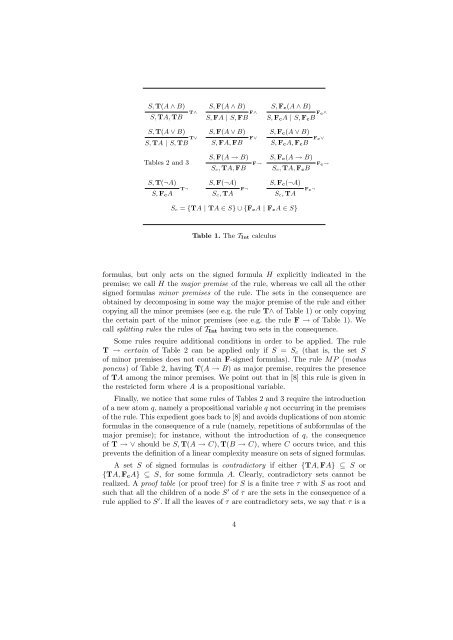A refined calculus for Intuitionistic Propositional Logic - DISCo
A refined calculus for Intuitionistic Propositional Logic - DISCo
A refined calculus for Intuitionistic Propositional Logic - DISCo
You also want an ePaper? Increase the reach of your titles
YUMPU automatically turns print PDFs into web optimized ePapers that Google loves.
S, T(A ∧ B) S, F(A ∧ B) S, F c(A ∧ B)S, TA, TB T∧ S, FA | S, FB F∧ S, F cA | S, F Fc∧cBS, T(A ∨ B) S, F(A ∨ B) S, F c(A ∨ B)S, TA | S, TB T∨ S, FA, FB F∨ S, F cA, F cB Fc∨Tables 2 and 3S, F(A → B) S, F c(A → B)S c, TA, FB F→ S c, TA, F cBFc→S, T(¬A) S, F(¬A) S, F c(¬A)S, F cA T¬ S c, TA F¬ S c, TAS c = {TA | TA ∈ S} ∪ {F cA | F cA ∈ S}Fc¬Table 1. The T Int <strong>calculus</strong><strong>for</strong>mulas, but only acts on the signed <strong>for</strong>mula H explicitly indicated in thepremise; we call H the major premise of the rule, whereas we call all the othersigned <strong>for</strong>mulas minor premises of the rule. The sets in the consequence areobtained by decomposing in some way the major premise of the rule and eithercopying all the minor premises (see e.g. the rule T∧ of Table 1) or only copyingthe certain part of the minor premises (see e.g. the rule F → of Table 1). Wecall splitting rules the rules of T Int having two sets in the consequence.Some rules require additional conditions in order to be applied. The ruleT → certain of Table 2 can be applied only if S = S c (that is, the set Sof minor premises does not contain F-signed <strong>for</strong>mulas). The rule MP (modusponens) of Table 2, having T(A → B) as major premise, requires the presenceof TA among the minor premises. We point out that in [8] this rule is given inthe restricted <strong>for</strong>m where A is a propositional variable.Finally, we notice that some rules of Tables 2 and 3 require the introductionof a new atom q, namely a propositional variable q not occurring in the premisesof the rule. This expedient goes back to [8] and avoids duplications of non atomic<strong>for</strong>mulas in the consequence of a rule (namely, repetitions of sub<strong>for</strong>mulas of themajor premise); <strong>for</strong> instance, without the introduction of q, the consequenceof T → ∨ should be S, T(A → C), T(B → C), where C occurs twice, and thisprevents the definition of a linear complexity measure on sets of signed <strong>for</strong>mulas.A set S of signed <strong>for</strong>mulas is contradictory if either {TA, FA} ⊆ S or{TA, F c A} ⊆ S, <strong>for</strong> some <strong>for</strong>mula A. Clearly, contradictory sets cannot berealized. A proof table (or proof tree) <strong>for</strong> S is a finite tree τ with S as root andsuch that all the children of a node S ′ of τ are the sets in the consequence of arule applied to S ′ . If all the leaves of τ are contradictory sets, we say that τ is a4
















